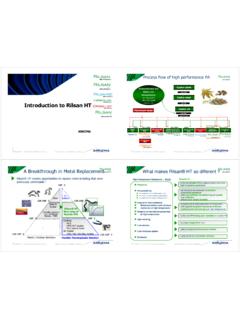Transcription of Compostable Plastics 101 - Composting Council
1 1 Compostable Plastics 101 AN OVERVIEW OF Compostable Plastics SPONSORED BY THE CALIFORNIA ORGANICS RECYCLING Council 2 Compostable Plastics 101 An increasing number of products labeled with terms such as biobased , biodegradable, and Compostable , are being developed for expanded applications. Many of these are targeted towards food service uses where they may help facilitate the collection of food scraps for Composting . Composters may or may not be involved in the discussion of whether or not a food scrap collection program accepts these materials, however, composters are being asked to accept these materials or even promote the use of these materials. As the number of food scrap collection and Composting programs across the increases,1 stakeholders need to address some of the questions surrounding the use and acceptance of these materials at commercial Composting facilities. This paper provides an overview of the Compostable Plastics industry by defining basic terms, outlining the characteristics of Compostable Plastics , and highlighting the challenges and opportunities presented by these Plastics .
2 It is our hope that the paper will answer some key questions and foster an intelligent dialogue as these programs move forward. INTRODUCTION Oil and natural gas are the major raw materials used to manufacture most Replacing petroleum-based Plastics with Plastics made from renewable raw materials, such as plants, reduces our dependence on fossil fuels. Replacing petroleum-based Plastics with Plastics designed to degrade, biodegrade, or compost can provide even more environmental benefits. biobased and Compostable Plastics , also known as bioplastics, hold the potential to reduce dependence on fossil fuels, foster the development of more sustainable products, and increase the diversion of food waste from landfills. However, bioplastics also present challenges and create uncertainty for a wide array of stakeholders. Inconsistencies in product labeling and a lack of accepted definitions for industry terms cause confusion for consumers upon purchasing and when discarding the products.
3 Improperly sorted bioplastics can contaminate recycling streams, contaminate feedstock for Composting operations, or end up buried in a landfill. Inconsistent rates of decomposition from product to product can impede commercial Composting operations. 1 Rhodes Yepsen, Residential Food Waste Collection And Composting , BioCycle 50, no. 12 (2009): 39. 2 American Chemistry Council , Life Cycle of a Plastic Product, (accessed March 30, 2011). 3 ASTM Standard D6400, 2004, Standard Specification for Compostable Plastics , ASTM International, West Conshohocken, PA, 2004, DOI: , Compostable Plastic: Plastic that undergoes degradation by biological processes during Composting to yield CO2, water, inorganic compounds, and biomass at a rate consistent with other known Compostable materials and that leaves no visible, distinguishable, or toxic 3 Bioplastics comprise less than 1% of the Plastics in use today,4 but the Plastics industry s desire to reduce its reliance on fossil fuel, combined with consumers increasing demand for environmentally benign disposable products are predicted to spark explosive growth in bioplastics production.
4 The growth in bioplastics demand is expected to increase by 35-40% annually between 2009 and As the bioplastics and Compostable Plastics industry rapidly expands, all players involved in their life cycle need to be in conversation if this industry is going to meet its potential for greater sustainability. DEFINING BIOPLASTICS AND Compostable Plastics The word bioplastics can cause confusion because it holds two meanings. Bioplastics can refer to the following: 1. Where the material comes from : A plastic made from a biobased origin such as corn, sugar, or starch, as opposed to a fossil-based carbon source. biobased Plastics are also called plant-derived or products that are derived from new carbon or organic carbon, or renewable carbon. 2. Where the material goes after use : A plastic that biodegrades in some time frame that is relevant, meaning it will decompose in closer to a year than 1,000 years, which is a normal rate for fossil fuel-based Plastics .
5 There is a common misconception that the terms biobased and biodegradable are interchangeable. Not all biobased Plastics will biodegrade. Many biobased products are designed to behave like traditional petroleum-based plastic, and remain structurally intact for hundreds of years. As the mainstream Plastics industry faces higher petroleum feedstock pricing, extreme price volatility, and increased demands to provide Plastics offering a lower environmental burden, industry players are developing and offering biobased versions of their current products ( Polyethylene/PE and Polyethylene terephthalate/PET). These materials are chemically identical to the existing petroleum-based products ( , the same molecule is being produced), with the only difference being that the building blocks, or monomers, from which the polymer is manufactured are shifting to biobased origin. Notable examples most recently include Coca Cola s bio-PET (partially biobased ), and Braskem s fully biobased polyethylene (PE).
6 These materials meet definition # 1 above. 4 European Bioplastics, Bioplastics at a Glance, (accessed March 30, 2011). 5 Melissa Hockstad, Bioplastics Find Fertile Ground for Growth, Trade and Industry Development, (accessed March 30, 2011). 6 American Chemistry Council , The History of Plastic, (accessed April 5, 2011). Did you know? The first plastic ever made was a bioplastic called Parkesine that was invented in the mid 19th century and was made from 4 Another common misconception is that all petroleum-based Plastics remain structurally intact for hundreds of years. Some petroleum-based Plastics can compost. For example, the chemical company BASF s product Ecoflex is manufactured from petroleum feedstock and is readily Compostable , but not biobased7. It is important to note that Plastics can also be created by blending biobased raw materials with petroleum-based raw materials, so a plastic can be partially biobased .
7 To summarize, Plastics are created from three common sources of raw material: 1. Petroleum-based resources (oil and natural gas) 2. biobased resources (plants) 3. Blending of petroleum-based and biobased resources ( a 50% biobased product) The raw material from which a plastic is created does not dictate if a plastic will biodegrade or compost. Figure 1 provides a grid depicting beginning of life plastic content and end-of-life characteristics for a variety of existing plastic types listed mainly by acronym. It shows end of life characteristics do not depend on the amount biobased content used to create a product. FIGURE 1. Plastics DIVERSITY (SOURCE: SPI BIOPLASTICS Council ) With biobased Plastics being designed to exhibit a tremendous range of characteristics similar to that of petroleum-based Plastics , and some being created from blending petroleum and biobased material, the distinction between bioplastics and conventional petroleum-based Plastics is becoming blurred8.
8 7 Ramani Narayan, The Science behind Compostable Plastics and the ASTM Standards, Lecture, 2011 US Composting Council Conference, Santa Clara, CA, January 26, 2011. 8 Steve Davies, Overview and context, types of materials ( Compostable vs biodegradable vs recyclable), Lecture, 2011 US Composting Council Conference, Santa Clara, CA, January 26, 2011. 5 Compostable Plastics As bioplastics and Compostable Plastics increase in the marketplace, effective end-of-life management has become increasingly important. Bioplastics designed to be recycled need to be segregated for processing, and bioplastics designed to biodegrade in certain environments need to be delivered to the appropriate environments, such as Composting facilities. End-of-life management is the arena where composters need to be involved in the stakeholder discussions in order to identify methods to make the system work for their individual operations.
9 Of particular concern for commercial composters is whether the materials they take into their facilities will compost in an appropriate timeframe. All organic matter will eventually biodegrade. This includes petroleum products and derivatives such as plastic products. However, the rate of biodegradation of different organic materials can vary on an exponential scale. Therefore, the term biodegradable is essentially meaningless without being tied to a specific timeframe and environment. Without further description based on time and environment, the term biodegradable does not distinguish between a product that biodegrades in the soil in a thousand years, and one that biodegrades in a compost pile in 180 days. By refining the definition of biodegradable with environmental conditions, and timeframes, we can create a useful tool for understanding how a product will perform in different end-of-life scenarios.
10 A plastic product designed to biodegrade does not necessarily compost. Plastics are designed to biodegrade in specific environments, including a marine environment, sunlight, soil, and some are intended to be properly managed at an industrial compost facility. A Compostable plastic is defined by the standards association ASTM International (ASTM) as a plastic that undergoes degradation by biological processes during Composting to yield carbon dioxide (CO2), water, inorganic compounds, and biomass at a rate consistent with other known Compostable materials and that leaves no visible, distinguishable, or toxic residue. According to the Federal Trade Commission (FTC), a biodegradable product is one that in its entirety will completely break down and return to nature, , decompose into elements found in nature within a reasonably short period of time (one year)11 after customary disposal .12 9 ASTM D6400.




